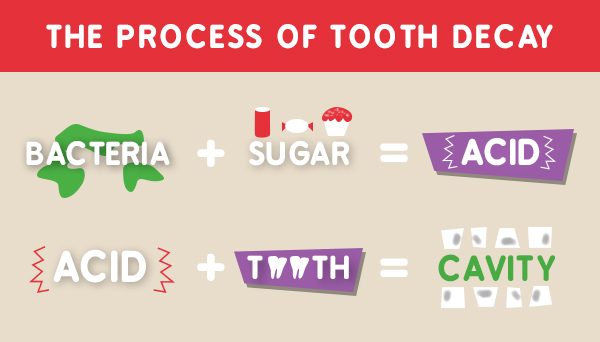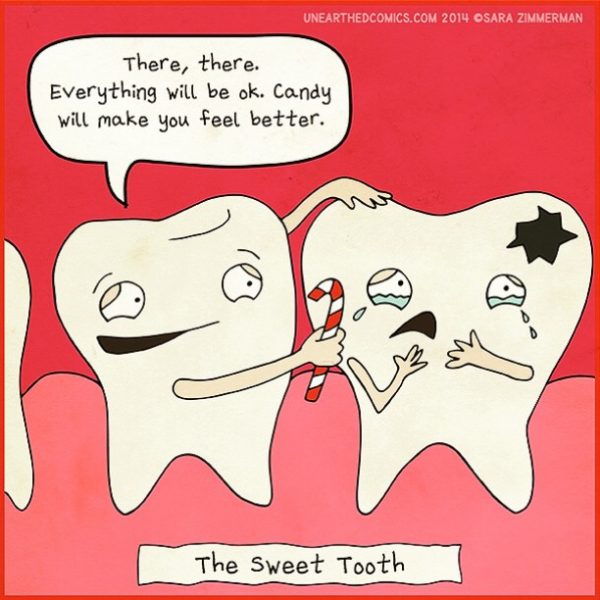It’s almost Halloween! A time when your inner child (or maybe outer child) is tempted by delicious gooey chocolate covered caramel and sticky gummy candy that somehow, inevitably, always gets wedged in your teeth. You try to resist, but that darn chocolate is literally calling your name! So you look around to see if the coast is clear and proceed to shove a glorious handful in your mouth, when all of a sudden an image of your dentist wagging his or her finger pops into your head (right?). Darn it! You stop and think to yourself, “Wait a second, how does this affect my teeth? How do cavities form? And what can I do to prevent this?” (right?!?!…no?). Well, well, my sugar-loving friend, you’ve come to the right place. Let’s start with how sugar affects your teeth and how this can result in cavities!
 Mmmmm…Sugar
Mmmmm…Sugar
You’re not the only one that enjoys the delicious taste of sugar; the bacteria do too! Dental plaque, which is a sticky film composed mostly of bacteria, is constantly being accumulated on your teeth. Some of this bacteria is helpful but some can also be harmful, causing oral diseases and tooth decay. The bacteria in dental plaque metabolizes the sugar in your mouth which keeps them alive and happy. This metabolization of sugar results in the bacteria producing acid that gets deposited on your teeth and gums. Over time, this acid can demineralize the enamel, causing this layer of the tooth to weaken and essentially form a small hole in your tooth. This hole is what we refer to as a cavity or dental caries.

The acid starts off by wearing away the enamel (the outer layer of the tooth), can move into the dentin (the second layer of the tooth), and if left untreated, can eventually get large enough that it enters into the pulp (the innermost layer where the nerves of the tooth are). The dentin layer is softer than the enamel and therefore, is less resistant to erosion caused by acid. This layer also contains many tiny tubules that communicate directly with the pulp or nerve layer of the tooth. Dental decay that reaches into the innermost layer of the tooth can cause pain, discomfort and even infections.

Location, Location, Location
People of all ages can get cavities on their teeth. There are generally three areas where cavities can form:
- Coronal cavities: These areas of decay happen on the ‘crown’ of the tooth, where the bacteria must break through the enamel layer. Typically these cavities will form on the biting surface of the tooth or in between teeth. The biting surface of the teeth have many pit and grooves where bacteria can easily get caught. Bacteria can also become stuck in between each tooth and can only be removed by flossing (or other interdental aids) or coming in for dental hygiene cleanings. Cavities can also form along the junction of where the tooth and gums meet as this is where the bacteria usually accumulate.
- Root cavities: For some people, the gums around your teeth can recede, exposing the root of the tooth. This part of the tooth is not covered by enamel, instead there is a layer of what is called, cementum. Cementum is not as strong as enamel and thus is more prone to the formation of cavities on the root surface of the tooth.
- Recurrent cavities: Many people believe that once a tooth is treated by having a filling, crown or root canal, that cavities can no longer develop on these teeth. However, these areas tend to accumulate plaque if not properly cleaned and decay can form around and under a previously treated tooth.
Not All Cavities Are Equal
Cavities are separated into 4 categories (according to the G.V. Black classification): incipient, moderate, advanced and severe.

Incipient cavities refers to decay that has just started to break through the enamel layer. This happens by demineralization (a loss of minerals) which causes the tooth surface to weaken and this weakening eventually results in the formation of cavities on the teeth. However, if caught early, these incipient cavities can sometimes be remineralized through proper brushing, flossing, and fluoride treatments. Here at Apollonia Dental Clinic, we refer to these areas as “watches”. They are best diagnosed through the use of x-rays and allow us to monitor an area before it turns into a full cavity. With proper home care, these small cavities can sometimes stop from progressing, thus preventing the need to do a filling.
Depending on how deep the decay reaches in the tooth will determine what kind of treatment can be provided. Cavities can usually be treated by doing fillings, a procedure where the dentist takes out the decay and fills the tooth with a dental-compatible material (i.e. composite). However, as a cavity becomes larger, more treatment may be necessary to save the tooth. This can involve doing crowns or root canal treatments. If a tooth becomes so broken down that it cannot be saved or becomes severly infected, your dentist may also recommend to remove the tooth.
Typically cavities do not have pain, discomfort or any symptoms until it is too late. Therefore, early detection through dental x-rays, regular dental check-ups and cleanings is extremely important to prevent extensive dental treatment, toothache, infections and even tooth loss.
Food!
The occurrence of cavities is influenced by many things such as:

- The composition of the teeth
- The type and quantity of bacteria
- The composition and flow rate of saliva (i.e. having dry mouth can result in an increase in cavities)
- Presence or absence of fluoride
- The presence and duration of sugars in the mouth
A large factor in the formation of cavities is the amount of sugars on the teeth. Unfortunately, the tastiest, most delicious, crave-worthy things are also usually the worst for our dental health (and overall health!). These types of food are called cariogenic, because they promote the development of tooth decay. Sugars can come in a variety of forms and are often hidden in many foods. Carbohydrates and starchy foods such as bread, cakes, cookies, sweetened cereals, etc., will break down into sugar by the enzymes in the mouth. Sticky foods such as candies and even dried fruit have a high retention in your mouth and can get stuck in between your teeth and within the fissures of your teeth. Sugary drinks including sodas, sweetened coffee/tea and fruit juices cause constant exposure of sugars on your teeth, especially if you tend to sip them throughout the day.

So then, what can you eat?!? Why fibrous vegetables, of course (yay)! But also, whole fruits, nuts, and milk/yogurt products have been shown to be good for your teeth and can stimulate saliva flow. If you’re like us and love popcorn and cheese, then you’re in luck! These foods are non-cariogenic and not to mention delicious (unless you eat your popcorn drizzled with caramel and chocolate, in which case, we can be friends but your teeth won’t like it)! Chewing sugar-free gum or having xylitol products can also help prevent cavities
TL;DR (Too Long; Didn’t Read)
- Chocolate is delicious but not the best for your teeth. Oral bacteria love sugar too!
- Cavities are caused by the metabolization of sugar by oral bacteria resulting in acid being deposited on the teeth and wearing away the layers of the tooth
- If caught early, some cavities can be stopped or may just need simple fillings. The longer you leave a cavity, the bigger it gets and the more extensive treatment you will need.
- Untreated cavities can result in pain, infections and even tooth loss.
- Cavities often do not hurt or have symptoms until it is too late
- Prevention is key!!
- Cavities can form on all of your teeth, even previous filled or treated teeth, as well as on the root surface of your tooth
- The best way to prevent cavities is to maintain proper brushing and flossing at home, come in for regular dental hygiene cleanings (*cough* floss), get your dental check-ups with x-rays (*cough* floss), use fluoride products (*cough* floss), try to limit the amount of sugar you intake (*cough* floss), and oh yes, did we mention…flossing?
- Avoid all the best foods and beverages such as cakes, cookies, breads, sweetened sodas, etc. Try to eat more vegetables, fruits, nuts, popcorn and cheese!

Nerd out!
Do you love all things science and nerdy to the max? Does the sound of complicated bacteria names make you feel an inexplicable excitement to your very core?! Do you want to impress your friends and family with your vast dental knowledge at your next dinner party (which they will L.O.V.E)? Then never fear! This random facts section is for you!
- Did you know that Early Childhood Caries (ECC) is the most common chronic childhood disease? It is about 4-5 times more common than asthma, 7 times more common than hay fever, and more prevalent than rubella, mumps, measles, chickenpox and pertussis.
- Streptococcus mutans, a facultative anaerobic bacteria, is one of the main contributors to the development of tooth decay.
- The foods and beverages you consume are immediately broken down in your mouth by an enzyme called Amylase. This enzyme exists in the oral cavity and catalyzes the hydrolysis of large starch compounds into smaller sugars molecules such as maltose. This breakdown of starch allows the bacteria to metabolize the sugars through glycolysis; producing acids that eventually cause the degradation of your tooth structures.
- The pH of plaque and saliva in the oral cavity also play an important role in tooth decay. Enamel dissolution is thought to occur around a pH of 5-6 with an average pH of 5.5. Plaque and saliva that drops below a pH of 5.5 can cause demineralization in the tooth. Remineralization of the tooth structures can occur as the pH of the mouth rises.
Learn More!
Visit the links below to learn more about cavities!
- http://www.mayoclinic.org/diseases-conditions/cavities/symptoms-causes/syc-20352892
- https://www.cdc.gov/healthywater/hygiene/disease/dental_caries.html
- http://www.colgate.com/en/us/oc/oral-health/conditions/cavities/article/what-are-cavities
- https://www.cda-adc.ca/en/oral_health/talk/complications/diseases/cavities.asp
- https://spoonuniversity.com/lifestyle/6-best-foods-teeth
- http://healthyeating.sfgate.com/definition-cariogenic-foods-3416.html




